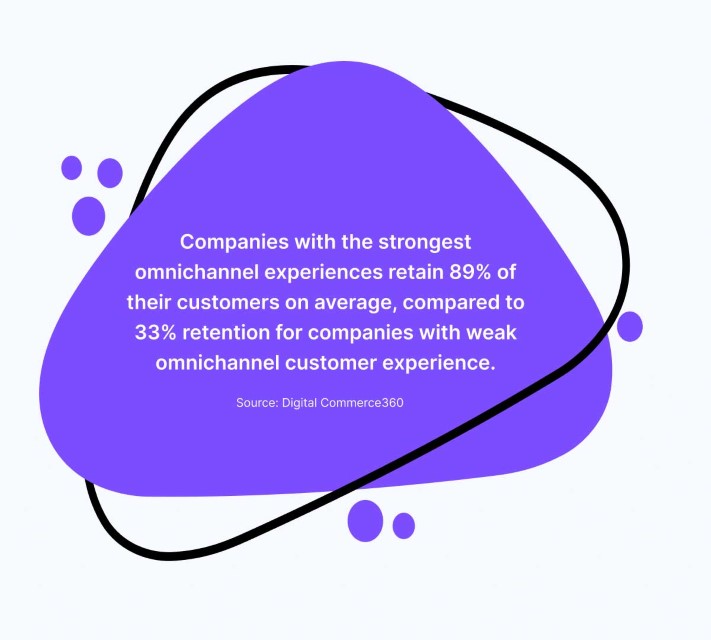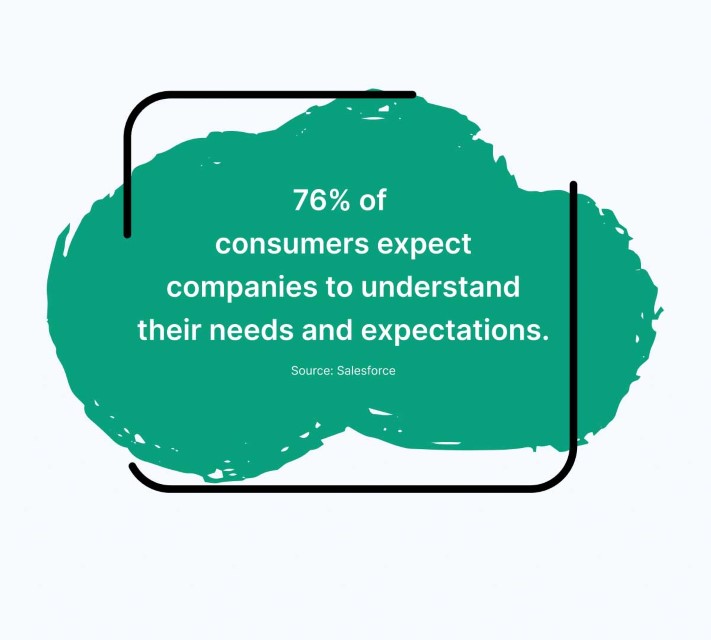Regardless of the quality of your product or service, if you create obstacles for customers in terms of accessing your services, buying your products, obtaining customer support, or finding solutions to their inquiries, you won’t retain them as customers for an extended period.
Your responsibility is to guarantee a positive experience in every interaction a customer has with your business and brand. This entails addressing their needs promptly at every phase of their customer journey. Satisfaction leads to loyalty, transforming customers into devoted fans. As loyal supporters, they not only return for future transactions but also enthusiastically endorse your business, bringing in new customers and serving as a consistent source of referrals.
Once you attain such a high standard of service, your business won’t just survive; it will flourish. Sounds great, doesn’t it? So, how do you achieve this? It’s referred to as Customer Experience Transformation, and it’s a strategy you can put into practice in your business right now. Sounds interesting? Keep reading to know more!
Defying Customer Experience Transformation
How to build customer trust? To begin, let’s delve into the concept of customer experience—it encompasses all aspects of a business that influence a customer’s perceptions and emotions. It includes customer service and extends to the purchasing process, marketing initiatives, advertisements, and more.
When the customer experience operates smoothly, your customers will be satisfied, and your business will prosper. However, every business will eventually encounter the need for a customer experience transformation. While undertaking such a transformation is no easy task—it is intricate, demanding, and impacts every facet of the business—and it is becoming more and more crucial.
And here lies the challenge: a customer experience transformation is not a singular undertaking. Businesses need to consistently fine-tune and enhance the customer experience to adapt to evolving expectations and market dynamics. However, to kick things off, there are three essential components that McKinsey partner Nicolas Maechler has identified as vital for a successful customer experience transformation:
- Wholehearted commitment to customer-centricity from the leadership to establish a unified vision
- Revamping and digitizing customer journeys
- Establishing a continuous, real-time customer feedback loop accessible to as many employees as feasible
According to McKinsey’s research, a customer experience transformation that effectively integrates these elements can enhance customer satisfaction by 20–30%, yield economic benefits ranging from 20–50% of the costs linked to transforming the customer journey, and elevate employee satisfaction by 10–20%.
The Game-Changing Impact of CX Transformation
When you undertake a customer experience transformation in your business, you will eventually see various advantages, extending beyond just having satisfied customers. These include:
-
Enhanced Performance
Optimizing processes enhances both the customer and staff experiences, fostering a positive service culture and creating a more efficient and productive environment for everyone involved.
-
Heightened Adaptability
The ever-evolving consumer needs and preferences, along with dynamic market conditions, necessitate adaptability. Prioritizing CX enables you to respond to changes swiftly and pivot more effectively.
-
Increased Retention
Enhanced customer satisfaction in their interactions with your brand typically cultivates increased loyalty, ultimately contributing to a higher Customer Lifetime Value (CLV) for your company.
-
Improved Efficiency
Prioritizing the customer experience cultivates more efficient teams within your organization. These teams collaborate to offer the best possible support, creating a collaborative environment dedicated to exceptional customer service.
Facilitating the Transformation of Customer Experience: 3 Easy Steps
Introducing modifications within an organization can be a daunting task. The process becomes even more intimidating when the changes need to be implemented across every department of your business. Without a well-defined plan, the likelihood of failure increases significantly.
Luckily, there exists a systematic approach you can adopt to effortlessly integrate customer experience transformation into your business, minimizing stress for both yourself and your employees. Ideally, the only noticeable change for your customers should be that conducting business with you has become significantly more convenient.
To reconsider the way your organization tackles customer experience, you must take into account these essential foundational elements:
-
Envision the Service Standard You Aim to Provide
How do you envision the customer experience? To actualize this ambitious vision, it’s important to concentrate on your company’s purpose and your brand’s commitment. To achieve this, consider your company mission and pinpoint the desired shifts in customer behavior. Once identified, it becomes straightforward to prioritize people over numbers.
-
Revamp Your Business Entirely
This isn’t intended to instill fear, but rather to emphasize that implementing change using traditional, “the way it’s always been” programs is not effective. If you are dedicated to customer experience transformation, be prepared to embrace the necessary changes for it to succeed.
Instead of distributing responsibilities among various departments in your organization, which can result in communication issues and a lack of individual ownership, establish a new team with cross-functional collaboration. This team should possess technical expertise, a problem-solving mindset, and a strong commitment to taking full ownership of their roles. These people should be capable of redesigning customer experiences and enhancing your products and services to align better with your brand.
-
Develop New Capacities
As these changes take effect, you must have the necessary infrastructure in place to support them. The specifics will vary depending on the type of your business and industry, but they are likely to encompass several essential elements.
But how? Here are a few ways!
1. Provide Continuous Training for Your Team Members
These involve “technical skills,” such as utilizing specific software or technology, and “interpersonal skills,” encompassing empathy and effective communication.
Imagine being the first point of contact for a customer seeking assistance – if the person handling the call lacks the necessary skills, it not only leads to prolonged wait times (either on the phone or waiting for a callback) but also increases frustration with each passing moment. It’s a scenario we’d all want to avoid.
So, you have to arrange training sessions regularly for the overall improvement of your team members.
2. Employ Technology for a Positive Omnichannel Customer Experience
Seamless integration among all platforms is essential to ensure convenience for both customers and the employees directly assisting them. Picture the challenges that could arise if a customer places an online order and subsequently contacts your company for assistance, only to discover that your employees lack access to the online ordering system.
3. Use Big Data to Address Gaps in Customer Experience
Although gathering feedback from customers is invaluable, it seldom provides a wholly accurate depiction of their experiences, emotions, and word-of-mouth communication. By leveraging predictive analytics and machine learning, you can assess the quality of each customer interaction, understand their satisfaction level, and predict whether they will remain loyal patrons of your company.
Many times feedback from customers might not be to your liking. Even if you find it hard to believe, agree with, or comprehend how someone can think about your company like this, the difficult truth is that this is what they think about your business. If you intend to maintain a working relationship with these customers, it’s essential to acknowledge and embrace the feedback.
The Impact of Digital Transformation on Customer Behaviour
The transformation brought about by digital advancements has notably impacted customer behavior. The ascendancy of digital technologies has led to a shift in customer expectations, placing greater emphasis on convenience and speed. The following outlines several ways in which customer behavior has changed.
-
Experience Across Multiple Channels
Previously, customers may have been happy to engage with brands solely through only one channel, such as making a phone call or visiting a physical store. However, in today’s digitally transformed landscape, customers expect smooth interactions across multiple channels. For example, they might initiate product exploration on a mobile app, transition to a desktop website, and complete a purchase using a chatbot.
-
Engagement in the Digital Realm
There’s a growing trend of consumers choosing online channels to communicate with brands. Social media platforms such as Twitter, Facebook, and Instagram have become crucial communication tools. Customers not only follow brands but actively participate by providing their feedback, and queries, offering suggestions, and engaging in various ways.
-
Dominance of E-commerce
The ease of online purchasing and the advancement of e-commerce platforms have profoundly changed how consumers make purchases. Today, many of us often choose online product exploration and buying over traditional brick-and-mortar retail experiences. The COVID-19 era further expedited this trend, with an increasing number of people opting for online shopping to fulfill their needs.
-
Transformation in Mobile Experiences
Mobile devices have also revolutionized customer behavior. With the widespread adoption of smartphones and tablets, people can now access information, make purchases, and engage with brands at any time and from any location. Businesses also find mobile apps and adaptable websites vital in catering to this mobile-savvy customer base.
-
Real-Time Assistance
Thanks to advanced technologies like AI-powered chatbots and digital transformation, organizations can now provide real-time customer care. Customers no longer wish to endure being placed on hold or waiting for email responses. They expect prompt and efficient assistance 24/7, and companies that employ chatbots and automated support systems can effectively meet this demand.
Embarking on Digital Transformation: Initiating the Journey
Now the question is how digital transformation is driving the customer experience. In today’s digital landscape, you must undergo a digital transformation to remain competitive. To meet customer expectations for a smooth omnichannel experience and personalized conversations, it is essential to leverage new technologies and adopt innovative business models. Digital transformation is a strategic, long-term approach for businesses to flourish in the digital age.
Integrating digital transformation with CX varies across businesses, but some principles universally hold. Let’s discuss how you can do it effectively.
-
Create a Digital Strategy
Before embarking on any digital transformation strategy, it is imperative to digitally assess three key aspects:
- Where is your current position?
- Where do you aspire to be?
- What is your plan to reach your destination?
Jumping headlong into a digital transformation merely for the allure of the latest technologies can lead to overwhelming challenges. The impact of successful digital transformation on customer experience lies in prioritizing sustainability. Therefore, the strategic planning process should be meticulous and deliberate, aligning with your business’s capabilities, and the necessary technologies, and considering the potential impact on your customers.
-
Prioritize the Evolving Customer Journey
While you may believe your brand has command over its digital future, this is only partly true. The enduring success of digital transformation hinges on retaining existing customers and expanding the customer base.
Therefore, a digital transformation should concentrate on understanding how alterations will impact the B2B customer journey. While disruption is a commonly used term in the tech realm, customers also value their comfort zones. Hence, contemplating digital transformation without completely interrupting the customer journey is a crucial balancing act.
-
Implement the Appropriate Technology
Once you’ve synchronized your digital transformation strategies with customer experience, the next consideration is the approach to implementation. Numerous “cutting-edge” customer experience management tools are competing for your business’s attention, yet the practical adoption of new digital solutions depends completely on your technical infrastructure and internal workforce.
Making sure we meet customer needs swiftly is all about optimizing the tools in use and ensuring their seamless integration. It’s a win-win situation for all. I’ve found that adopting open and composable technologies on a digital experience platform (DXP) is a fantastic way to bring different solutions together harmoniously.
-
Leverage Customer Data for Personalized Approaches
It’s very important to make customer data the focal point of any digital transformation initiative aimed at improving the customer experience. Some of the most impactful digital transformations that companies undergo are centered around customer data.
Improving how your organization gathers, stores, analyzes, and acts upon customer data is key to personalizing content. This approach allows you to build a more accurate data profile of your customers, enabling strategic planning. Utilize customer data to deliver digital experiences that deeply resonate with them, guiding them seamlessly toward their objectives.
-
Master Omnichannel Experiences
Effective digital transformation enhances customer experiences across all touchpoints with your brand. With the growing number of digital channels, it’s essential to deliver consistent content across each one. Headless and hybrid solutions empower organizations to create content that can be seamlessly published on various channels to reach customers wherever they are. A successful example of this approach is the Metropolitan Transportation Authority (MTA), which leveraged headless publishing techniques to disseminate content to 1,800 signs across over 400 stations throughout NYC.
The current and future landscape of CX is defined by omnichannel digital interactions. As your customers engage across various channels, guaranteeing an easy and consistent experience will minimize customer attrition and uphold a robust brand presence.
Launch Your Digital Transformation with REVE Chat
From this discussion, it’s evident that the link between digital transformation and customer experience is a matter modern businesses cannot afford to approach haphazardly or overlook. Given our reliance on technology, digital transformation necessitates a comprehensive and well-thought-out solution.
REVE Chat is crafted to streamline the digital transformation process for both your organization and customers. Serving as an omnichannel customer engagement platform, it enables you to provide an excellent experience to your customers, whether they visit your website, use your mobile app, or attempt to connect via various social media platforms such as Facebook, Instagram, Telegram, Viber, and WhatsApp.
REVE Chat enables you to provide immediate assistance to your customers 24/7. Your support agents can oversee all customer interactions from a unified dashboard. The platform allows real-time monitoring of your customers, empowering you to offer personalized assistance proactively, anticipating their needs before they even inquire.
The AI-powered chatbot from REVE Chat automates your customer service and other business operations, even outside regular working hours or when all support agents are occupied with other critical tasks.
Interested in giving it a try? REVE Chat provides a 14-day free trial to explore all its distinctive features. So, SIGN UP today!








